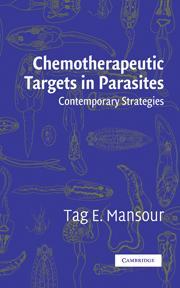Book contents
- Frontmatter
- Contents
- Preface
- Acknowledgments
- 1 The Search for Antiparasitic Agents
- 2 Biophysical, Genomic, and Proteomic Analysis of Drug Targets
- 3 Energy Metabolism in Parasitic Helminths: Targets for Antiparasitic Agents
- 4 Antimalarial Agents and Their Targets
- 5 Antitrypanosomal and Antileishmanial Targets
- 6 Targets in Amitochondrial Protists
- 7 Neuromuscular Structures and Microtubules as Targets
- 8 Targets in the Tegument of Flatworms
- Epilogue
- Index
- References
8 - Targets in the Tegument of Flatworms
Published online by Cambridge University Press: 11 August 2009
- Frontmatter
- Contents
- Preface
- Acknowledgments
- 1 The Search for Antiparasitic Agents
- 2 Biophysical, Genomic, and Proteomic Analysis of Drug Targets
- 3 Energy Metabolism in Parasitic Helminths: Targets for Antiparasitic Agents
- 4 Antimalarial Agents and Their Targets
- 5 Antitrypanosomal and Antileishmanial Targets
- 6 Targets in Amitochondrial Protists
- 7 Neuromuscular Structures and Microtubules as Targets
- 8 Targets in the Tegument of Flatworms
- Epilogue
- Index
- References
Summary
Trematodes and cestodes have their external surface covered with an unusual structure termed the tegument. In addition to protecting the parasite from adverse conditions in the host, it has many other functions. These include evasion of the host immune system, the absorption of certain nutrients and the excretion of some metabolic products, control of motility, and control of electrochemical and osmotic gradients. Studies on the structure and biochemistry of the tegument have lately been emphasized when it was discovered that the tegument is the main target for some important antischistosomal agents such as praziquantel and metrifonate.
Most of our information on the tegument in trematodes came from studies on the liver fluke Fasciola hepatica (Threadgold, 1963) and the blood fluke Schistosoma mansoni (Hockley, 1973; Hockley & McLaren, 1973; McLaren & Hockley, 1977). A recent comprehensive review on the teguments of cestodes and trematodes as well as the cuticle in nematodes is also recommended (Thompson & Geary, 1995). This chapter focuses on trematodes and cestodes.
Structure and Function of Schistosome Tegument
Figure 8.1 is a schematic diagram of the typical components of the dorsal tegument of an adult male S. mansoni determined from electron microscopic transmission (Hockley, 1973). The tegument consists of cytoplasmic syncytium 2–4 μm thick, which is a mass of dense granular material that contains no separate cells. The syncytial zone of the tegument is separated from the muscle layer and subtegumental cells by a membranous basal lamina, a regular trilaminate lipid bilayer.
- Type
- Chapter
- Information
- Chemotherapeutic Targets in ParasitesContemporary Strategies, pp. 189 - 214Publisher: Cambridge University PressPrint publication year: 2002
References
- 4
- Cited by

